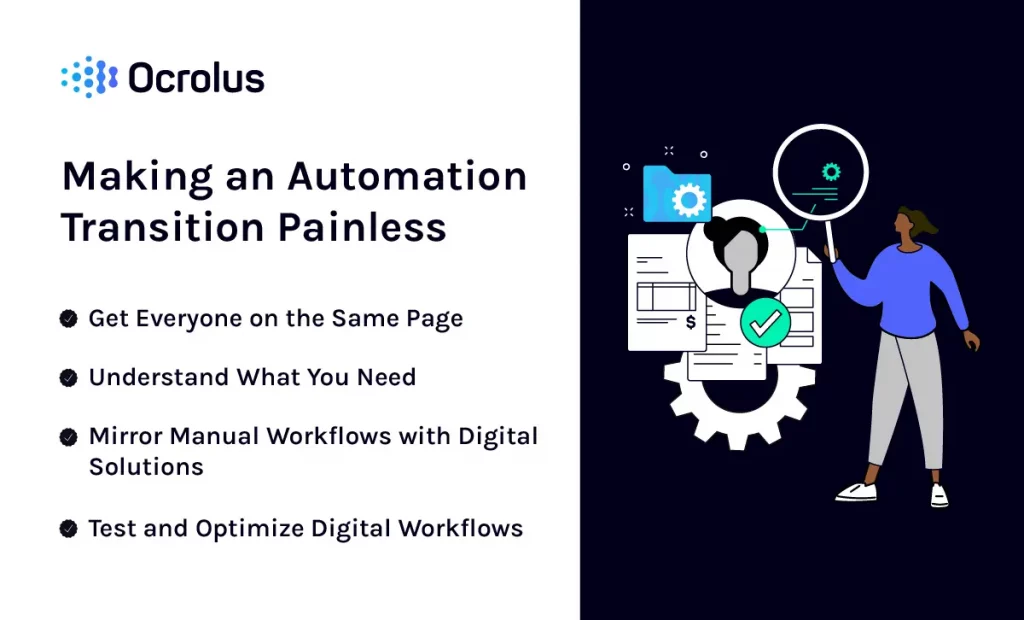This website uses cookies so that we can provide you with the best user experience possible. Cookie information is stored in your browser and performs functions such as recognising you when you return to our website and helping our team to understand which sections of the website you find most interesting and useful.
4 Steps to Making an Automated Workflow Transition Painless

Document automation and the transition to automated workflows can be messy and requires organizations with multiple stakeholders to carefully assess how existing processes can benefit from change.
Thoughtful planning can streamline your automated workflow transition. Here are four best practices that will help you streamline the transition from manual to automated document workflows.
Get Everyone on the Same Page
Developing and implementing a workflow automation strategy is a team sport. It’s mission-critical that all of your key stakeholders — from your colleagues in the trenches to the decision-makers in the executive suite — buy into the automation transition.
“Despite its perceived complexity and difficulty, securing buy-in is fairly simple and straightforward,” notes a report from the Project Management Institute. “Give your audience what they want and they will give you back what you want from them, as long as it is commensurate.”
In other words, your team will buy into your document automation transition strategy if you can demonstrate the value of investing time in developing automated workflows for the organization and/or for individual stakeholders. Of course, when it comes to automation, there are many selling points, ranging from speed and efficiency to better analytics for decision-making and lower customer acquisition costs.
Understand What You Need for an Automated Workflow
Understanding how automation will benefit existing workflow processes starts with developing a strategy that maps whatever tasks need to be completed.
To establish the rules for automated document workflows, you need to reverse engineer the steps in the process. For instance, once you understand the steps required to automate customer relationship tasks, you can focus on closing deals rather than manual data entry.
Many financial institutions, for example, are using underwriting document automation to streamline their underwriting workflows. Developing a strategy for automated underwriting requires that you understand more than just your manual document and data processing steps. You also need to ensure that automated fraud detection and detailed cash flow analytics are part of your roadmap.
Mirror Manual Workflows with Digital Solutions
You can make the transition from manual to automated workflows easier by starting with similar steps in a process. The goal is to mirror your existing manual processes with a roadmap for automation.
Perhaps, for instance, a marketing email requires approval by three people before sending it out. You might start by having each step approved by the same people and in the same order. You could then automate the flow. Once person A approves the email, it is delivered to person B and then to Person C. When the email is approved, the software sends it automatically to the intended recipient.
Another simple document automation step would be to replace physical records with digital files. Instead of requiring hard copies of approvals to go into a file, digital versions can automatically be stored in the designated network directory.
As we discussed in another blog post on the evolution of document management systems, machine learning enables you to harness the power of artificial intelligence to help you continuously improve automated workflows and to optimize the models governing everything from document management and archiving to pricing and risk management
Test and Optimize Digital Workflows
Another benefit of automation is that it can be refined to meet your needs. It’s important to thoroughly test new digital workflows before mothballing your legacy processes. As your organization becomes more agile, you also need to ensure that your automated workflows are aligned with your organization’s compliance and security requirements.
“We’ve found that the best companies establish active collaboration between risk, security, IT, and the business units,” says a report from McKinsey Digital. “They have a comprehensive understanding of the changes needed at the operating-model, technology, and culture levels — and a coordinated approach to the actions to take, and in what order.”
Mapping out the order in which manual processes are handled will facilitate the creation of digital workflows. It also can help you to identify ways to improve efficiency. For example, maybe it is necessary to eliminate some steps.
Automation is not just a question of programming it and then forgetting about it. The process needs to be refined based on user experiences. One of the ways in which automation is being successfully deployed by financial institutions is through robotic process automation (RPA) applications. These automated workflows balance efficiency with the need to protect privacy and comply with government regulations. RPA can streamline digital workflows for banks and fintech firms and help them reach their digital transformation goals.
For many tasks, like document indexing and document automation, financial institutions can implement digital workflows that recognize and process documents with better than 99% accuracy. That means you can replace the time-consuming and labor-intensive task of document processing with an automated document workflow that will scale as your needs grow. To better understand key industry terms related to document processing, automation, and more, visit our Glossary.
Ready to learn more about how Ocrolus can help you automate your workflows? Book a demo with one of our experts today.






